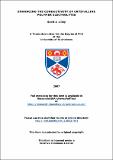Files in this item
Enhancing the conductivity of crystalline polymer electrolytes
Item metadata
| dc.contributor.advisor | Bruce, Peter G. | |
| dc.contributor.author | Lilley, Scott J. | |
| dc.coverage.spatial | 116 | en |
| dc.date.accessioned | 2008-05-15T09:21:34Z | |
| dc.date.available | 2008-05-15T09:21:34Z | |
| dc.date.issued | 2007-11-30 | |
| dc.identifier | uk.bl.ethos.552050 | |
| dc.identifier.uri | https://hdl.handle.net/10023/481 | |
| dc.description.abstract | The AsF₆⁻ anion, in the crystalline polymer electrolyte PEO₆:LiAsF₆, was replaced with the larger N(SO₂CF₃)₂⁻ anion. This produced an increase in the room temperature ionic conductivity of 1.5 orders of magnitude. It is believed that the enhancement is the result of the disruption of the electrostatic field around the lithium ions. The presence of the large and asymmetrical N(SO₂CF₃)₂⁻ ion creates a greater number of defects and thus enhances conductivity. These results demonstrate for the first time the enhancement lithium ion conductivity in a crystalline polymer electrolyte by isovalent doping. XF₆⁻ anions, in the crystalline polymer electrolyte system PEO₆:LiXF₆, were replaced by another anion of similar size and shape. A continuous solid solution was obtained for PEO₆:(LiAsF₆)₁₋ₓ(LiSbF₆)ₓ. These results represent the first continuous solid solution demonstrated in the field of crystalline polymer electrolytes. They also show for the first time an enhancement of conductivity caused only by the size of the dopant anion. The enhancement is believed to originate from changes in the length of the crystal axis and changes in the potential landscape around the lithium ions. The structures of the glyme complexes monoglyme:LiAsF₆, hexaglyme:LiAsF₆, octaglyme:LiAsF₆, undecaglyme:LiAsF₆ and dodecaglyme:LiAsF₆ have been solved. There structures are discussed and compared to that of PEO₆:LiAsF₆. The properties of these complexes together with those of diglyme:LiAsF₆, triglyme:LiAsF₆ and tetraglyme:LiAsF₆ were investigated. Triglyme:LiAsF₆ has been shown to demonstrate high ionic conductivity of 10[superscript(-5.5)] Scm⁻¹ at 30°C as well as a high transport number of 0.8. These complexes demonstrate the control that crystal structure has over ionic conductivity. These complexes are neither ceramic nor polymeric. A number of the complexes show plastic crystal like solid-solid phase transitions. | en |
| dc.format.extent | 2675 bytes | |
| dc.format.mimetype | application/pdf | |
| dc.language.iso | en | en |
| dc.publisher | University of St Andrews | |
| dc.rights | Creative Commons Attribution 3.0 Unported | |
| dc.rights.uri | http://creativecommons.org/licenses/by/3.0/ | |
| dc.subject | Lithium | en |
| dc.subject | Solid | en |
| dc.subject | Electrolytes | en |
| dc.subject | Conductivity | en |
| dc.subject | Electrochemistry | en |
| dc.subject | Doping | en |
| dc.subject | Complexes | en |
| dc.subject | Crystalline | en |
| dc.subject.lcc | QD382.P64L5 | |
| dc.subject.lcsh | Polyelectrolytes | en_US |
| dc.subject.lcsh | Crystalline polymers | en_US |
| dc.subject.lcsh | Electrolytes--Conductivity | en_US |
| dc.title | Enhancing the conductivity of crystalline polymer electrolytes | en |
| dc.type | Thesis | en |
| dc.type.qualificationlevel | Doctoral | en |
| dc.type.qualificationname | PhD Doctor of Philosophy | en |
| dc.publisher.institution | The University of St Andrews | en |
This item appears in the following Collection(s)
Except where otherwise noted within the work, this item's licence for re-use is described as Creative Commons Attribution 3.0 Unported
Items in the St Andrews Research Repository are protected by copyright, with all rights reserved, unless otherwise indicated.


